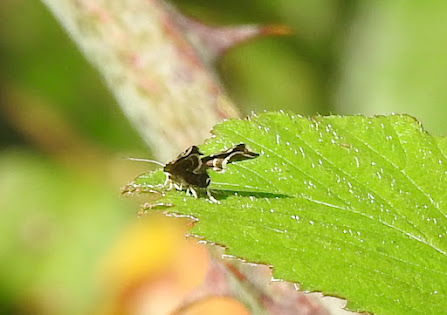I was up nice and early, arriving at Morton Bagot at about 04.20 just as the first hint of light appeared in the eastern sky. The weather was set fair, and it looked like we would have the largest team ever assembled here for the alldayer.
First bird was a Moorhen which "pook"ed from the direction of the old pool. My main emphasis as always was to try to add some owls to the list, and indeed I heard a Tawny Owl hoot in the distance (bird 3), and the gentle "purr" of a Barn Owl (bird 7). I walked down from Bannams Wood and was soon ticking off many of the species I had listed as very likely. These included Grasshopper Warbler although there seemed to be only one singing, a pair of Shelducks (which evidently disappeared as they weren't seen again all day) and a drake Teal, which I was half expecting to be absent.
Two birds which were missing were Avocet and Little Ringed Plover, both of which have been present recently.
The first team member to arrive was Tony K. He had set up some mist nets in the reed bed at the dragonfly pool and I followed him round as he unravelled them. The only Reed Warbler on site was singing there, and we also saw the only Coot currently breeding. Several Pied Wagtails made a sharp exit, and had obviously been roosting, and Tony found he had caught a male Reed Bunting almost straight away. He planned to move the nets to Stapenhill Wood later in the morning.
No Cuckoo was calling, and that was to be another bird we missed out on.
I spent the last hour before I had to nip home below Bannams Wood, and added a calling Nuthatch and a singing Coal Tit to the list. These were both species that have been missed in earlier alldayers.
By the time I returned it was 8.00am and the team was assembling and finding stuff. Martin W had joined the ringers, and I spotted Gary J and Andy G in the distance. It was nice to meet Andy and to discover that he had found what was arguably the bird of the day, a male Redstart. Unfortunately for the rest of us it soon disappeared.
The ringers had caught two excellent birds, a Sparrowhawk and a Jay. I don't think anyone saw another Sparrowhawk, and only SamMcV later found a Jay.
 |
| Sparrowhawk (Tony K) |
 |
| Jay (Tony K) |
After a quick tally up, we found we had reached 56 species, which didn't seem too bad. Gary, Martin and I headed for the flash field, adding a singing Goldcrest in the hedge, and a female Tufted Duck which flew towards us before returning the way it had come. I'm guessing it was headed to the small fishing pool just outside the recording area.
We joined Andy again, and Gary spotted a couple of distant House Martins, while Andy tried to get us on a very distant large gull. I ended up heading towards Netherstead with Gary, before we went our separate ways.
My route took me down the access road and I walked into a singing Garden Warbler, my best find of the day. I spent a long time listening to it, and tried videoing it to get the song recorded. I finally saw it quite well, but it was back in the thick stuff before I could get a shot.
During the afternoon I made contact with Sam McV, who was trying to tease something new out of Bannams Wood. I went back the the flash field and was relieved to find a
Black-headed Gull which has been missed in previous years, but had been regular here throughout April.
By now it was getting warm, and it was great to see loads of insects including my first Large Red Damselflies, and Small Heath of the year.
 |
| Large Red Damselfly |
 |
| Small Heath |
I forced myself to get back on message, and ended up at the raptor watchpoint from where I unexpectedly spotted a Hobby. Normally the phrase raptor watchpoint is stated with a degree of irony.
 |
| Record shot (barely) of the Hobby |
Buoyed by this success and decided to fight my way through the vegetation into Stapenhill Wood. This brought me the 63rd, and last, tick of the day, a Treecreeper.
By late afternoon I found myself staking out the flash field in the hope of either a Rook or a Starling, both absent from the list and possible in that area.
Gary returned for a last walk round, but I was too tired to keep going. Nothing further was added, so we had to settle for a slightly under par score of 63.

















































